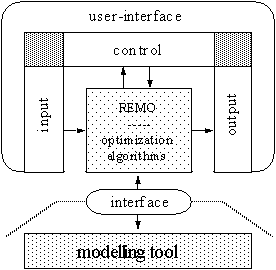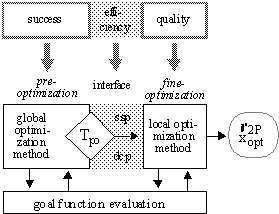
|
|
|
1 Introduction
The software tool REMO (REsearch Model Optimization Package) was primarily developed to automate the process of model optimization. It comprises a library of powerful direct optimization algorithms which are applicable to both parameter optimization of analytical and simulation models. Direct optimization means that only goal function values are required to guide the optimization process. Additional analytical information like gradients, etc. is not used. Beside the optimization algorithms REMO provides an interface to connect it with conventional modelling tools. Together with a modelling tool REMO enables the user
· to specify the optimization problem,
· to automatically perform the model optimization process.

2 Architecture
The architecture of the model optimization tool REMO is presented in Fig. 1. The basic components are:
2) a library of powerful direct optimization algorithms,
3) an interface for coupling REMO with a conventional modelling tool.
3 Functionality
In the following the functionality of each component of REMO is explained in detail.
3.1 Graphical User-Interface
When working with REMO, the user has to handle a multitude of input parameters and to cope with a high quantity of output data, generated during the optimization process. In order to get a well structured user-interface, which is easy to survey, it was subdivided into an input-, control-, and output part.
Input Part
The input part enables the user to specify optimization experiments. Such a specification comprises the following aspects:
· choice of an appropriate optimization strategy,
· adjustment of the control parameters of the applied optimization method,
· choice of different possibilities for visualization of the optimization process (textual or graphical),
· specification of size and kind (screen and/or file) of the optimization output report which informs about the optimization effort, result, and trajectory.
The control part enables the user to interactively control the running optimization process. For that purpose possibilities
· to modify the step size of the step mode,
· to modify control parameters of the running optimization algorithm,
· to skip a phase of the optimization process to avoid inefficiencies,
· to force the output of provisional results,
· to stop the running optimization process prematurely
Output Part
The main tasks of the output part are
REMO offers to the user an extensive library of direct optimization algorithms. Table 1 comprises the basic components of this library. Genetic Algorithms [2] and Simulated Annealing [1] represent powerful strategies for global optimization. The Pattern Search Algorithm of Hooke and Jeeves [3] is a very efficient local Hill-Climber. Outgoing from these basic components (so-called atomar strategies) the user can compose more sophisticated optimization methods (combined 2-phase optimization strategies or multiple-stage optimization strategies).
|
|
|
|
|
|
To be able to cope with the non-trivial task of model optimization we have developed a new class of direct optimization algorithms called combined 2-phase strategies. These strategies are based on the splitting of the optimization process into two phases: pre-optimization with a probabilistic global optimization method and fine-optimization performed by a deterministic local Hill-Climber. The task of pre-optimization is to explore the search space in order to find promising regions where global optimum points might be located. Outgoing from the results of pre-optimization the task of fine-optimization is to localize the optimum point in a promising region efficiently and exactly. Thus, pre-optimization is predominantly responsible for optimization success, whereas fine-optimization has to ensure optimization quality. Fig. 2 shows the basic structure of a combined 2-phase optimization strategy. The global optimization method is coupled with the local optimization method by means of an interface, comprising a method to derive control parameter values from optimization trajectories (dcp) as well as a method to select start points (ssp). After termination of pre-optimization by Tpo the task of dcp and ssp is to compute a favourable starting condition for fine-optimization.

Outgoing from the atomar global and local optimization methods presented in Table 1 there exist the following possibilities to realize a combined 2-phase strategy:
· Simulated Annealing + Pattern Search.
All optimization methods presented so far can be used for single-stage optimization within a multiple-stage optimization method. Multiple-stage optimization means that a single-stage method is executed several times successively in order to generate a sequence of optimum points. To avoid that previously found optimum points are located again in subsequent optimization stages a method called avoidance of reexploration is applied. The basic structure of a multiple-stage optimization algorithm using a combined 2-phase strategy for single-stage optimization is shown in Fig. 3. A more detailed description of multiple-stage optimization can be found in [6].

For special adaptation of the implemented optimization algorithms to intricate model optimization problems the software tool REMO offers supplementary methods for
· enhancement of the robustness against goal functions which are heavily distorted by stochastic inaccuracies.
In order to automate the process of model optimization a coupling of optimization and model analysis has to be realized. Therefore a specific interface was developed, comprising a data and a synchronisation part [4]. Input parameters and goal function values are exchanged using the data part. Synchronisation signals which manage the alternated switching between optimization and model analysis are exchanged using the synchronisation part.
4 Conclusions
REMO (REsearch Model Optimization Package) represents a software tool for optimization of analytical and simulation models. For that purpose REMO comprises a library of powerful direct optimization algorithms. Basic components of this library are atomar strategies which can be put together to more sophisticated methods like combined-2-phase and multiple-stage optimization strategies.
Combined-2-phase strategies try to combine the advantages of global and local search, i.e.
· to generate optimization results which satisfy user-specified quality demands,
· to ensure high efficiency.
· to generate heterogeneous sequences of optimum points,
· to localize the most prominent optimum points in early optimization stages.
References
[1] Aarts, Emile; Korst, Jan: Simulated Annealing and Boltzmann Machines; John Wiley & Sons, 1989.
[2] Goldberg, D.E.: Genetic Algorithms in Search, Optimization and Machine Learning; Addison-Wesley, 1989.
[3] Hooke, R.A.; Jeeves, T.A.: Direct Search Solution for Numerical and Statistical Problems; Journal ACM 8, pp. 212-221, 1961.
[4] Syrjakow, M.; Szczerbicka, H.: Optimization of Simulation Models with REMO; Proceedings of the European Simulation Multiconference ESM'94, Barcelona, Spain, June 1-3, 1994, pp. 274-281.
[5] Syrjakow, M.; Szczerbicka, H.: Simulation and Optimization of Complex Technical Systems; Proceedings of the 1995 Summer Computer Simulation Conference SCSC'95, Ottawa, Ontario, Canada, July 24-26, 1995, pp. 86-95.
[6] Syrjakow, M.; Szczerbicka, H.: Combination of Direct
Global and Local Optimization Methods; Proceedings of the International
Conference on Evolutionary Computing ICEC' 95, Perth, Western Australia,
November 29 - December 1, 1995.
Back to the Homepage